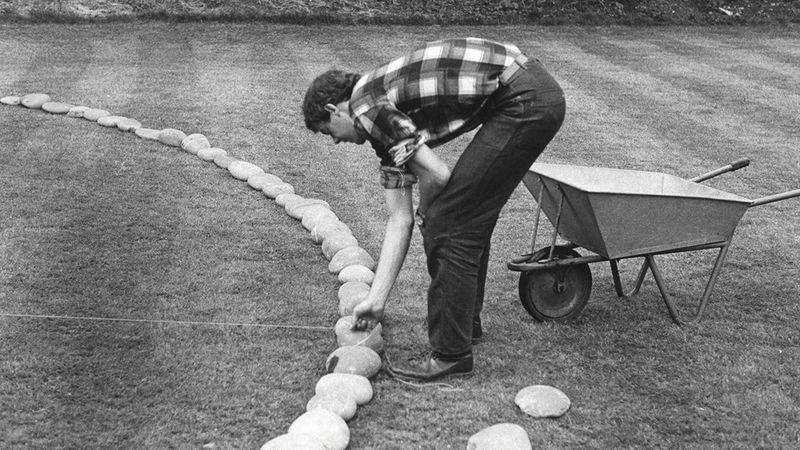THE JOURNAL

Mr Richard Long. Photograpy courtesy of Lisson Gallery
Pioneering artists Messrs Keith Arnatt, Richard Long, Bruce McLean and John Hilliard were also sartorially sharp. Look and learn.
If you’ve ever found yourself in a gallery staring at a pile of fruit or someone’s dirty underwear, and thinking simply, “I don’t get it,” then you will more than likely have had an encounter with the discipline known as “Conceptual Art”. In fact, most art these days is somewhat conceptual, that is, predominantly focused on the idea behind a piece, rather than, strictly speaking, what it looks like or how it was made. This is, of course, pretty much the opposite of the way in which you tend to look at your clothes – the general consensus here is that, although it’s nice if a pair of trousers is conceptually sound, it’s rather important that they are at least somewhat easy on the eyes. Yet, it turns out that the pioneers of conceptual art, whose work is brought together in the new Tate Britain exhibition, Conceptual Art in Britain, 1964-1979 (which opens on 12 April), were actually rather sartorially astute. Go figure. Below, we’ve brought together four of the best in all their long-haired, monochrome glory.
TAKE A PICTURE – IT LASTS LONGER

Mr John Hilliard. Photograph courtesy of Lisson Gallery
No, this is not a backstage shot from Mr Alessandro Michele’s latest adorkable collection for Gucci. In fact, it’s something of a proto-selfie, taken 40-odd years before that awful word was even invented, by Mr John Hilliard, an artist whose central preoccupation was revealing the complete unreliability of the photograph as a means of representation. He did this in works like 1971’s Camera Recording Its Own Condition (a grid of images of a camera taken in a mirror, the exposure and aperture changed in each one) and 1974’s Cause Of Death (a picture of a dead body, given four different meanings by four different crops). But crucially, he also had an enviable head of hair and, evidently, a fine collection of knitwear.
GO MONOCHROME

Pose Work for Plinths 3 by Mr Bruce McLean (1971). Photography © Mr Bruce McLean. Courtesy of Tanya Leighton Gallery, Berlin
Mr Bruce McLean’s Pose Work for Plinths 3 (1971) is something of a cheeky jab at the British art establishment, in which the artist parodies the stately, monumental figures of his forebear, the sculptor Mr Henry Moore, by draping himself over a series of plinths. Outfit-wise, though, there’s plenty to take seriously here – the neat black rollneck with matching slim trousers and sturdy lace-up boots has a sharp, graphic simplicity that would be just as at home on the runway at a contemporary Jil Sander show as it is here, used for thoroughly conceptual purposes.
DENIM AND PLAID JUST WORKS

Mr Richard Long. Photograph courtesy of Lisson Gallery
Mr Richard Long is one of the more outdoorsy, full-blooded conceptual artists. His 1970s works involved such healthy pursuits as going for long walks (as in Dartmoor Walks, 1972), during which he would create ephemeral sculptures out of stones, such as in the image above. In short, it’s the kind of conceptual art your personal trainer would approve of. And perhaps your Personal Shopper, too – the combo of blue denim jeans and a plaid shirt is a classically masculine look that has been in style pretty much since denim was invented. Mr Long’s styling twist of rolling up the sleeves clearly shows, in addition, that he’s a no-nonsense guy who doesn’t mind getting his hands dirty.
SOMETIMES SIMPLE IS BEST

Self-Burial (Television Interference Project) by Mr Keith Arnatt (1969) Photograph by Tate/Westdeutsches Fernsehen 1973 © Keith Arnatt Estate/DACS, London
It stands to reason: if you’re going to bury yourself head-deep in the ground and then broadcast a series of images of the feat on German TV – as Mr Keith Arnatt did for his Self-Burial (Television Interference Project) of 1969 – you should probably not wear anything too loud. In the resulting piece, Mr Arnatt investigated the concept of ephemeral sculpture, and by extension, whether the artist himself could disappear from an artwork. And that’s probably quite enough to chew on without throwing a Valentino print parka into the mix. Which is why the simple black henley tee and jeans works. (You can stay equally simple with MR PORTER’s curated edit of classic pieces, The Essentials).